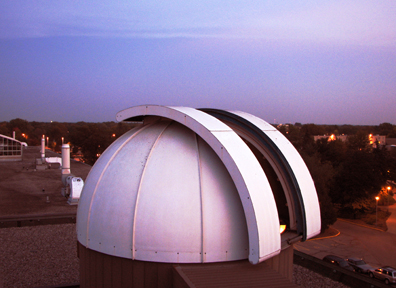
OBSERVATORY STATUS: Stargazing sessions will occur every week, on Monday, Tuesday, and Wednesday nights, from 8:30 until 10:00 PM, weather permitting. The public viewings will be hosted at the north end of Coleman Field, the running track on the corner of Maria Drive and Reserve Street (see the map below). Street parking is available along Reserve St.

Because these sessions are weather-dependent, a final decision regarding the status of the event will be made around 7:30-8:00 pm that night and posted HERE.
We will restart our public sessions in early February of 2026.
_______________________________
We offer observing sessions
every Monday, Tuesday, and Wednesday nights between 8:30-10:00 PM, weather permitting.
Located on the roof of the Science Building at the UW-Stevens Point campus, the Arthur J. Pejsa Observatory houses a 0.4-m (16-inch) Meade, computer controlled telescope. Normally the observatory is open for public viewing three nights per week (if the skies are clear) during the school year. Monday nights are specifically designed for the public while Tuesday and Wednesday nights are used primarily by astronomy students, but anyone is welcome. Public viewing runs from mid-September to mid-December, then late-January through mid-May. Most summers the observatory is closed. In the winter, dress warmly since the observatory temperature is the same as the outside temperature.
Access to the observatory is obtained by using the southwest stairwell in the Science Building and going to the fourth floor, room D402. Visitors are best advised to go to the third floor and follow the signs to the observatory by accessing the southwest stairwell. IF THE SKIES ARE CLEAR, on Monday, Tuesday, and Wednesday nights, from 8:30 p.m. until 10:00 p.m. the Arthur J. Pejsa Observatory is open and is staffed by knowledgeable astronomy students and staff who will find and describe various interesting objects that can be seen in the current night-time sky. The staff will then allow visitors to observe them through the telescope.
NOTE: IF SKIES ARE CLOUDY, THE OBSERVATORY WILL BE CLOSED. ALSO, IF THE TEMPERATURE DROPS BELOW ~10 DEGREES WE WILL ALSO DECIDE TO CLOSE DUE TO TECHNICAL CONSTRAINTS RELATED TO COMPUTER SCREENS, POOR COOMUNICATION BETWEENOMPUTERS, TELESCOPE, AND DOME.
The observatory can be contacted to determine if we are open and have clear skies from any touch-tone phone by calling (715) 346-2208 and selecting the observatory option (number 5) from the automated attendant. On Monday through Wednesday evenings we update our message at about 8:00 p.m. to give visitors our best estimate of the probability of clear skies and if the observatory will be open.
